GEARED LOCOMOTIVES ON
THE MOUNT TAMALPAIS RAILWAY.
Scientific American—July 16, 1898
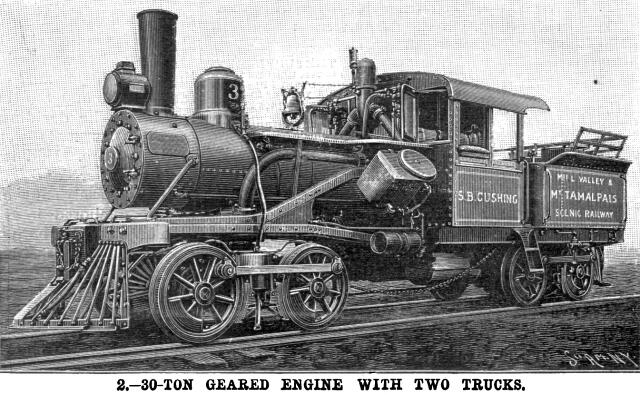 The geared
locomotive has had a somewhat extended trial in this country and
has proved itself to be a valuable means of traction under special
conditions. It has found a field of usefulness in the West, where
it has been used on logging and mining work, in which the grades
and curvature are heavy and the track is of the rough-and-ready
type. For this class of service the geared locomotive is admirably
adapted. It has a large hauling power in proportion to its weight,
and great flexibility. The geared
locomotive has had a somewhat extended trial in this country and
has proved itself to be a valuable means of traction under special
conditions. It has found a field of usefulness in the West, where
it has been used on logging and mining work, in which the grades
and curvature are heavy and the track is of the rough-and-ready
type. For this class of service the geared locomotive is admirably
adapted. It has a large hauling power in proportion to its weight,
and great flexibility.
To the mechanical sense there is, at first thought, something
objectionable in the idea of introducing the complication of gearing
into a locomotive; though the objection is more sentimental than
anything else, and is due, doubtless, to the fact that we have
come to associate the idea of high speed with the locomotive,
and have rightly determined that a direct connection is superior
to any other for fast work of this kind. On the other hand, it
is a fact that excellent results have been attained in electric
traction with geared motors, some of them of considerable size
and power.
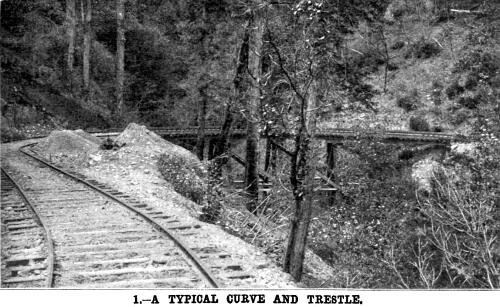 There are two
classes of geared locomotives. In one of these the engines are
placed vertically on the outside of the frame, and drive a horizontal
shaft which extends along the side of the locomotive and meshes
with gears formed on the faces of the driving wheels. In the other
class the engines drive a shaft which lies beneath the boiler
parallel to the axis, and carries bevel gears which mesh with
gears on the driving wheel axles. There are two
classes of geared locomotives. In one of these the engines are
placed vertically on the outside of the frame, and drive a horizontal
shaft which extends along the side of the locomotive and meshes
with gears formed on the faces of the driving wheels. In the other
class the engines drive a shaft which lies beneath the boiler
parallel to the axis, and carries bevel gears which mesh with
gears on the driving wheel axles.
On our front page we give illustrations of a 30-ton engine
of the central shaft class, which was designed by Mr. Charles
Heisler, consulting engineer, of Erie City, Pa., and is running
successfully on the Mount Tamalpais Scenic Railway, in California.
The road, which was built purely for tourist purposes, runs from
Mill Valley, a point near the Golden Gate, San Francisco Harbor,
to a point near the summit of Mount Tamalpais, a distance of 8.25
miles. The grades are heavy, varying from 5 to 7 per cent, and
there are about 275 curves, all of which are of from 70 to 75
feet radius.
The engine, as will be seen from the cuts, is carried on two
trucks, one under the forward end of the boiler and the other
under the tender, the tender and locomotive being built on the
same frame. On the forward axle of the leading truck and on the
rear axle of the trailing truck is secured a heavy bevel spur
wheel which gears with a bevel pinion whose shaft is carried by
a long 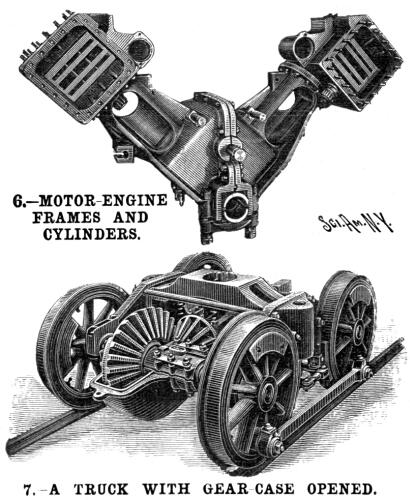 bearing
in a frame that is formed integrally with the inclosing gear case,
the upper half of which is shown removed in Fig. 7. The frame
is supported by a sleeve on the axle and is independent of the
truck frame, thereby insuring that the gears shall be maintained
at all times in proper alinement. The gear case, which is dust-proof,
enables the gears to run continuously in a bath of oil. The other
axle of each truck is driven from the main axle by means of coupling-rods,
as shown in Figs. 6 and 7. bearing
in a frame that is formed integrally with the inclosing gear case,
the upper half of which is shown removed in Fig. 7. The frame
is supported by a sleeve on the axle and is independent of the
truck frame, thereby insuring that the gears shall be maintained
at all times in proper alinement. The gear case, which is dust-proof,
enables the gears to run continuously in a bath of oil. The other
axle of each truck is driven from the main axle by means of coupling-rods,
as shown in Figs. 6 and 7.
The pinion shafts are inclined and extend the length of the
gear frame. At their inner ends they are connected by universal
joints with the main crank shaft, which extends parallel with
the axis of the boiler and just above the top of the inner axles
of the trucks.
The cylinders, one on each side of the boiler, are inclined
45 degrees to the vertical and drive inwardly and downwardly upon
the longitudinal crank shaft. Each cylinder is bolted to its own
hollow cast frame, and the two frames are securely bolted together
in the vertical longitudinal plane of the locomotive, the journals
of the main crank shaft being forayed in the bottom of the frame.
The engine frames are carried by the locomotive side frames, the
space between the top and bottom bars being considerably widened
to admit them. In the Heisler engines of a larger size four cylinders
are used, two on each side.
In designing these engines the boiler has been made of ample
capacity, to avoid over-forcing when the engine is working up
to its full capacity on heavy grades, and a large cylinder capacity
has been provided to insure ability to start with the heaviest
loads and maintain a good speed with economical consumption of
steam.
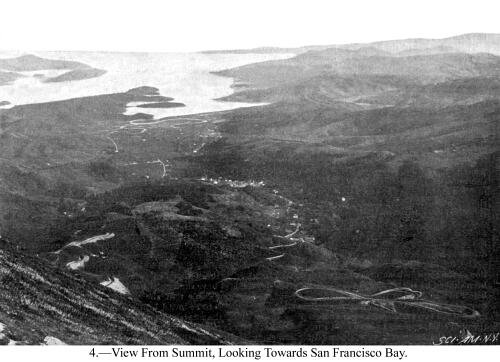 The universal
couplings are made of steel and phosphor bronze. They are clamped
upon the shafts, and may be readily removed. They have only a
slight angular movement and offer only a slight resistance to
the swing of the trucks in passing around the sharp curves which
abound on this railroad. The gear wheels are made unusually heavy,
so that, even when they have become weakened by wear, they may
be able to withstand the heavy shocks to which they are exposed. The universal
couplings are made of steel and phosphor bronze. They are clamped
upon the shafts, and may be readily removed. They have only a
slight angular movement and offer only a slight resistance to
the swing of the trucks in passing around the sharp curves which
abound on this railroad. The gear wheels are made unusually heavy,
so that, even when they have become weakened by wear, they may
be able to withstand the heavy shocks to which they are exposed.
The Mount Tamalpais Scenic Railway is situated in the southern
end of Marin County, California, and, as its name suggests, it
climbs the east peak of Mount Tamalpais, a rugged and picturesque
mountain that attains an elevation of 2,537 feet above the sea
in a distance of three miles. Marin County forms the north shore
of the famous Golden Gate of the Pacific, and is bounded on the
west by the Pacific Ocean and on the east by the Bay of San Francisco.
The summit of the mountain is twelve miles northerly from the
city of San Francisco and five miles easterly from the ocean.
The railway, which has a total length of 8.19 miles is built
to standard gage. The track is laid on ties 6 inches by 8 inches
by 9 feet long and the rails weigh, 56 pounds per yard. It is
thoroughly well ballasted and ample superelevation is provided
on all curves. Commencing at the little hamlet called Mill Valley
(75 feet above sea level), which nestles at the foot of the mountain,
the road ascends the valley of the Arroyo Corte Madera del Presidio
in a northerly direction for a distance of about two miles, at
which point the Arroyo is crossed by a trestle on a curve having
radius of 70 feet, with a total curvature of 182°. Continuing
westerly along the face of the mountain for another two miles,
winding in and out of many canyons, the "Mesa" is reached.
Here the topography of the country compelled the engineers to
overcome an elevation of 130 feet between points that were less
than 800 feet apart in an air line. This was accomplished by means
of what is now known as the "Double Bow Knot," where
the tracks parallel themselves five times, the shortest radius
of the curves at the turns being 75 feet. Here, at an elevation
of 1,150 feet, the expanse of the Pacific Ocean breaks into view.
Continuing westerly for a distance of two miles, the "West
Loop" is reached at an elevation of 1,800 feet, where a remarkable
turn of 252° is made, the radius of the curve being 80 feet
and the grade 5.2 per cent. The road now stretches in an easterly
direction and climbs to the Tavern of Tamalpais, which marks the
end the road at an elevation of 2,353 feet above the sea.
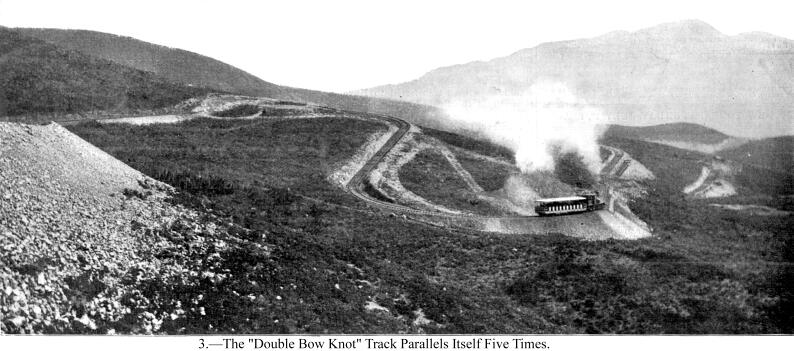
The average grade of the entire road is 5 per cent and the
maximum grade attained is 7 per cent. The grades have been somewhat
lightened on the curves to compensate for the increased resistance,
but in a few instances a 6 per cent grade has been maintained
upon curves of 70 feet radius. We are informed by Mr. George M.
Dodge, chief engineer of the road, to who we are indebted for
the engineering data, that in this short line there are 21 wooden
trestles having an agregate length of 1,703 feet. One of these
trestles shown in our illustrations crossing the canyon already
mentioned on a curve of 70 feet radius.
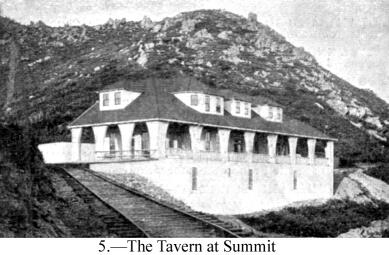 The excessive
curvature maybe judged from the fact that, out of the total length
of 8.19 miles, the total amount of straight line is only 3.282
miles, while the curvature is divided as follows: The excessive
curvature maybe judged from the fact that, out of the total length
of 8.19 miles, the total amount of straight line is only 3.282
miles, while the curvature is divided as follows:
26 curves of 70 feet radius 3,641 feet
24 curves of 80 feet radius 2,974 feet
20 curves of 90 feet radius 2,328 feet
49 curves of 100 feet radius 4,020 feet
46 curves of 110 to 150 feet radius 4,403 feet
59 curves of 150 to 300 feet radius 4,710 feet
42 curves of 300 feet radius and upward 3,837 feet
There are in all 266 carves on the road, and it speaks well
for the geared locomotives that they work very freely on the curves
and show no perceptible wear on the wheel flanges.
Mountain Railroading
| Contents Page
|







